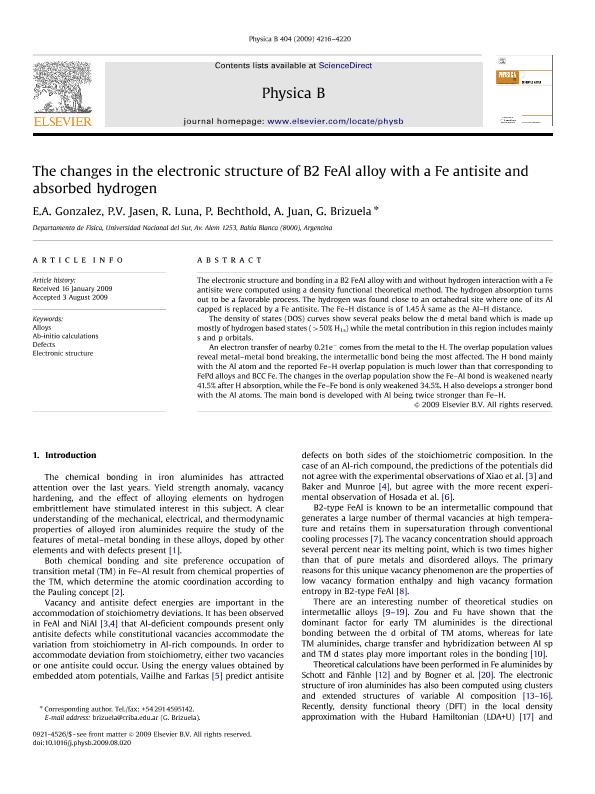Artículo
The changes in the electronic structure of B2 FeAl alloy with a Fe antisite and absorbed hydrogen
Gonzalez, Estela Andrea ; Jasen, Paula Verónica
; Jasen, Paula Verónica ; Luna, Carla Romina
; Luna, Carla Romina ; Bechthold, Pablo Ignacio
; Bechthold, Pablo Ignacio ; Juan, Alfredo
; Juan, Alfredo ; Brizuela, Graciela Petra
; Brizuela, Graciela Petra
 ; Jasen, Paula Verónica
; Jasen, Paula Verónica ; Luna, Carla Romina
; Luna, Carla Romina ; Bechthold, Pablo Ignacio
; Bechthold, Pablo Ignacio ; Juan, Alfredo
; Juan, Alfredo ; Brizuela, Graciela Petra
; Brizuela, Graciela Petra
Fecha de publicación:
08/2009
Editorial:
Elsevier Science
Revista:
Physica B: Condensed Matter
ISSN:
0921-4526
Idioma:
Inglés
Tipo de recurso:
Artículo publicado
Clasificación temática:
Resumen
The electronic structure and bonding in a B2 FeAl alloy with and without hydrogen interaction with a Fe antisite were computed using a density functional theoretical method. The hydrogen absorption turns out to be a favorable process. The hydrogen was found close to an octahedral site where one of its Al capped is replaced by a Fe antisite. The Fe-H distance is of 1.45 Å same as the Al-H distance. The density of states (DOS) curves show several peaks below the d metal band which is made up mostly of hydrogen based states (>50% H1s) while the metal contribution in this region includes mainly s and p orbitals. An electron transfer of nearby 0.21e- comes from the metal to the H. The overlap population values reveal metal-metal bond breaking, the intermetallic bond being the most affected. The H bond mainly with the Al atom and the reported Fe-H overlap population is much lower than that corresponding to FePd alloys and BCC Fe. The changes in the overlap population show the Fe-Al bond is weakened nearly 41.5% after H absorption, while the Fe-Fe bond is only weakened 34.5%. H also develops a stronger bond with the Al atoms. The main bond is developed with Al being twice stronger than Fe-H.
Palabras clave:
Ab-Initio Calculations
,
Alloys
,
Defects
,
Electronic Structure
Archivos asociados
Licencia
Identificadores
Colecciones
Articulos(IFISUR)
Articulos de INSTITUTO DE FISICA DEL SUR
Articulos de INSTITUTO DE FISICA DEL SUR
Citación
Gonzalez, Estela Andrea; Jasen, Paula Verónica; Luna, Carla Romina; Bechthold, Pablo Ignacio; Juan, Alfredo; et al.; The changes in the electronic structure of B2 FeAl alloy with a Fe antisite and absorbed hydrogen; Elsevier Science; Physica B: Condensed Matter; 404; 21; 8-2009; 4216-4220
Compartir
Altmétricas



